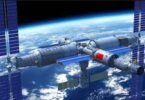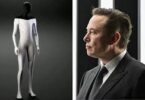BEIJING (life.ru): So far, the future Chinese space station looks pretty modest. But this is only the beginning: the first base module “Tianhe” (“Harmony of Heaven and Earth”) is in orbit, it was launched on April 29, 2021. It weighs 24 tons, for comparison: our module “Science” – 20 tons. The orbital altitude is 370 kilometers, that is, slightly lower (or closer to the Earth) than the International Space Station.
Soon a space truck Tianzhou-2 (Skyship-2) was sent to him, and then in June – Magic Ship-12 (Shenzhou-12) with three taikonauts on board. They spent three months in space: they adjusted and checked the equipment, twice went into outer space (each time for about six hours), monitored the parameters. We returned to Earth on September 17. So now the module is empty, it flies in automatic mode. On the 20th, another truck flew to him, the next team will be sent to unload it at the end of October. The composition of the crew has not yet been disclosed, but it is expected that it will include, in particular, the Chinese Alexei Leonov – the first taikonaut in outer space Zhai Zhigang (flew in 2008) – and a woman taikonaut, Lieutenant Colonel of the Chinese Air Force Wang Yaping.
All this is preparatory work. The appearance of the station will be formed around the fall of 2022: by that time, the Wentian (Questioning to the Sky) and Mengtian (Dream of the Sky) modules harmoniously docked on both sides of the Tianhe. The result will be an approximately 60-ton structure called “Tiangong” (“Heavenly Palace”), that is, it will be seven times smaller than the ISS. Three taikonauts will live and work on it (in fact, they will be accommodated in “Tianhe”). Yes, and there will be another module “Xuntian” (“Heavenly sentry”), but it will fly separately – this is a space telescope.
So, not the largest palace, and nevertheless – the third multi-module station in the world.
In terms of size, this is half of the “World”, but, probably, it is better in terms of technical capabilities, since electronics are modern, the Chinese work well in this area. This is their main task for the next ten years.
It is worth recalling a few more very remarkable circumstances. First, the Chinese were the second in the world to successfully land a rover. Moreover, they launched not only one rover, but a whole set of three vehicles: an orbital, a lander and the “Chzhuzhong” (“God of Fire”) rover itself. Since May 14, 2021, he has been driving across the Utopia Plain in the northern hemisphere of the Red Planet, where there are impressive deposits of water ice. To date, he has already covered more than a kilometer. And secondly, the Chinese were the first in the world to land a vehicle on the far side of the moon. The lunar rover “Yuytu-2” (“Jade Hare – 2”) has been exploring the deep (three kilometers) impact crater Von Karman since January 2019.
First, it is state prestige, a demonstration of one’s level of development of science and technology. The second is, in fact, the development of science and technology, because astronautics is an incentive for the development of a wide range of industries. And the third is defense, the issue of security, the issue of monitoring your potential competitors. And, of course, ensuring reliable communication
And recently, plans on a truly fantastic scale made a special impression: China planned to build a spaceship in orbit a kilometer or even several kilometers long. Now they are calculating how to do this, in general, they propose to launch relatively light components in turn, and then assemble a space colossus from them already in orbit. Why, one wonders? Basically, the goal is the construction of a solar power plant. For this, technologies for wireless transmission of electricity are already being tested – using microwaves or a laser. However, the Institute for Space Policy doubts the feasibility of this idea.
Many are doing this, many are writing about it, but this is a very distant prospect. They have been trying to build a power plant in orbit since the 60s, but it does not work, because there are too many energy transformations, and they are all with low efficiency.
And the founder of the Open Space project sees the true meaning of the giant spacecraft in something completely different.
China has a program to create a super-heavy rocket, and it reveals an obvious problem – the lack of demand for such a rocket in everything except the flight to the moon. Such gigantic investments need to be recouped somehow. To solve this problem, China comes up with all sorts of crazy ideas, just to come up with a job for a rocket after it has completed a priority task.
And all this is the same country that entered its space age 11th in the list of states with their own artificial satellites. Now it is confidently moving towards the status of the second leading space power. But whether Russia will be on the third line, according to experts, is not entirely clear.
We are actively moving in the opposite direction. If all other space powers increase their efforts in space, then we lose ground
Technologically, Russia has every opportunity to stay in the top three, economically – here it is already weaker, because our funding is comparable to that of India, and the only thing that keeps us in the top three is the Soviet potential, largely preserved by Roscosmos.
The Russian national station still exists only in the project, the launch of the Luna-25 spacecraft has been postponed for a decade, and all because Russia does not have the economic opportunities of China, let alone the United States, complained Vitaly Yegorov. The head of the Institute of Space Policy, in turn, called one of the problems the almost complete absence in our country of private companies working in the field of astronautics.






